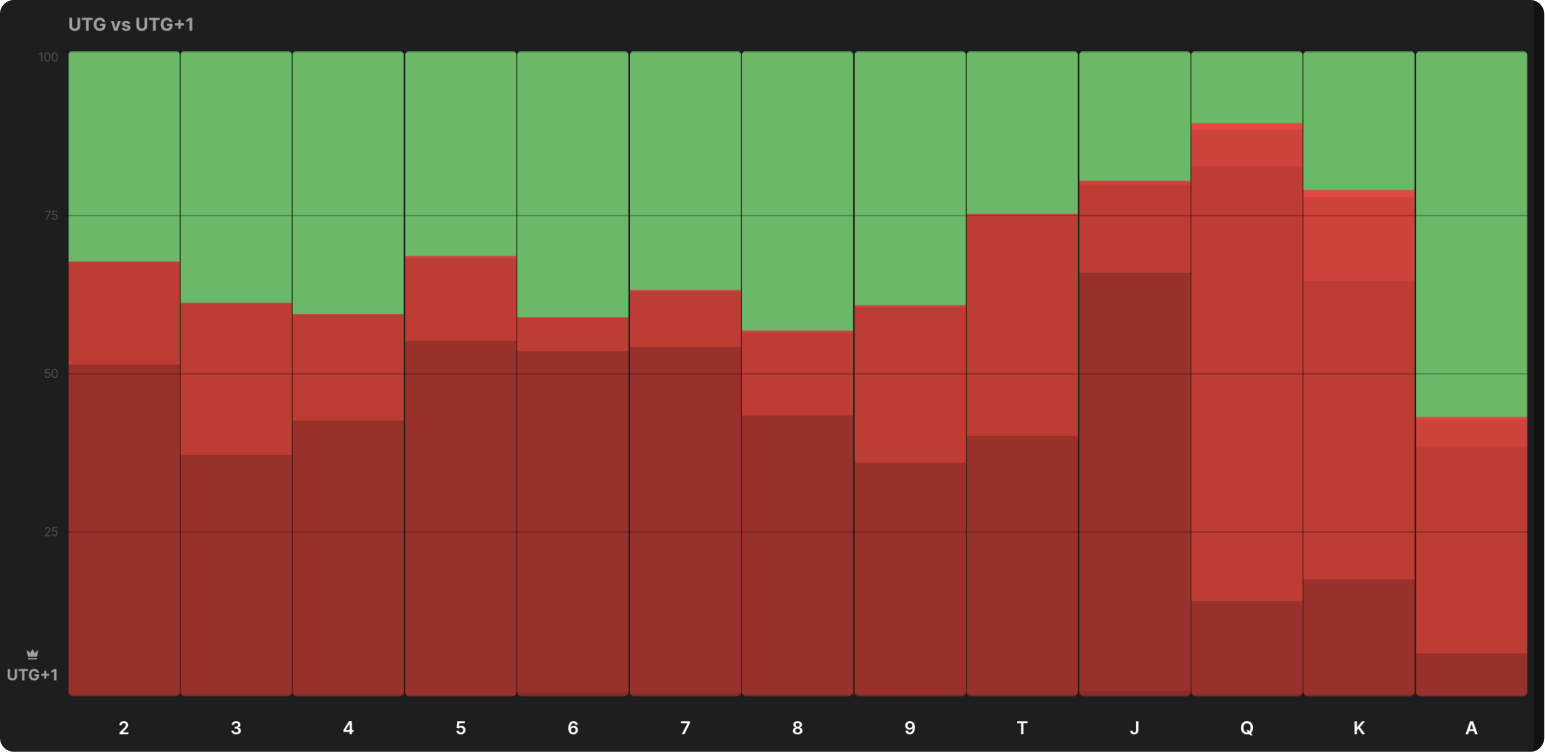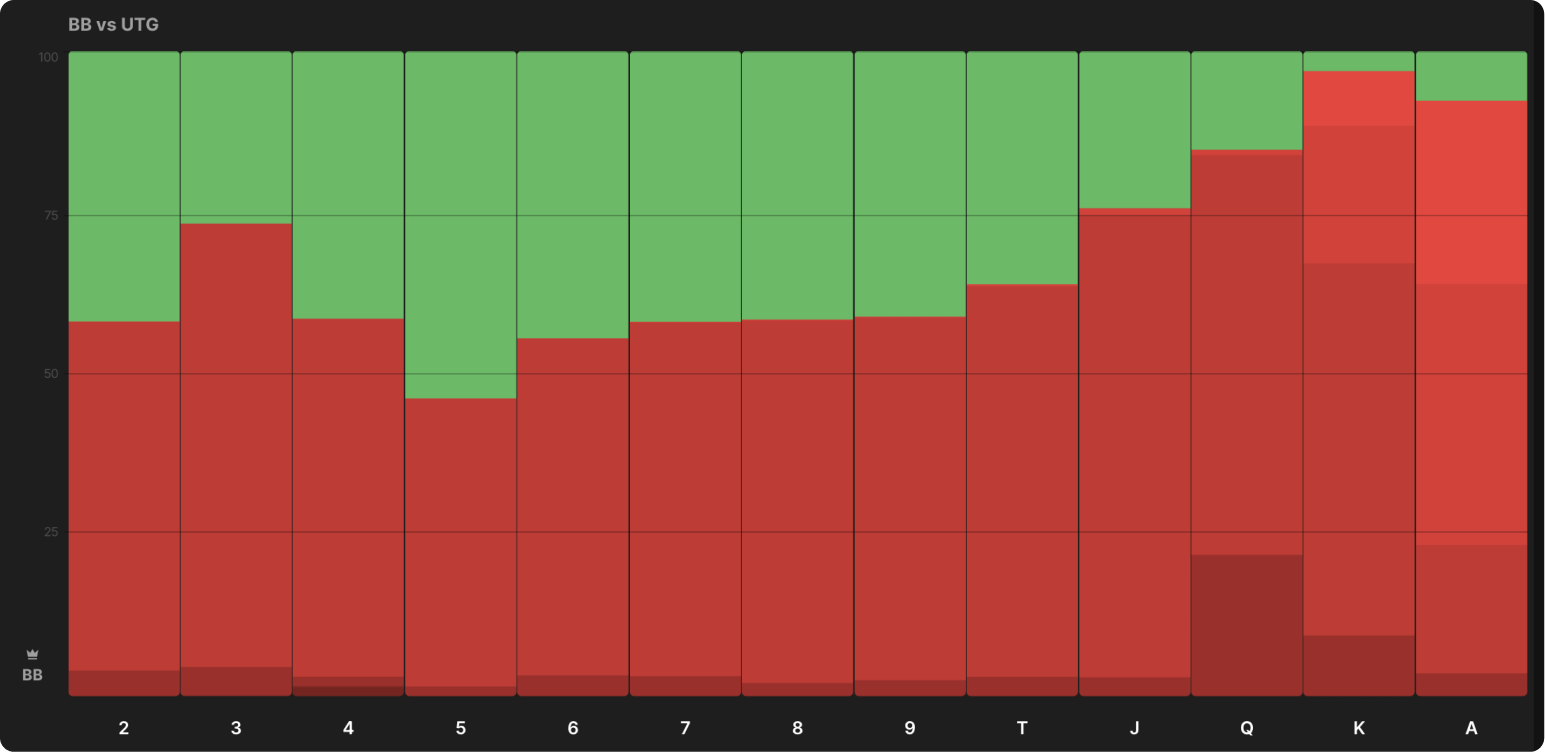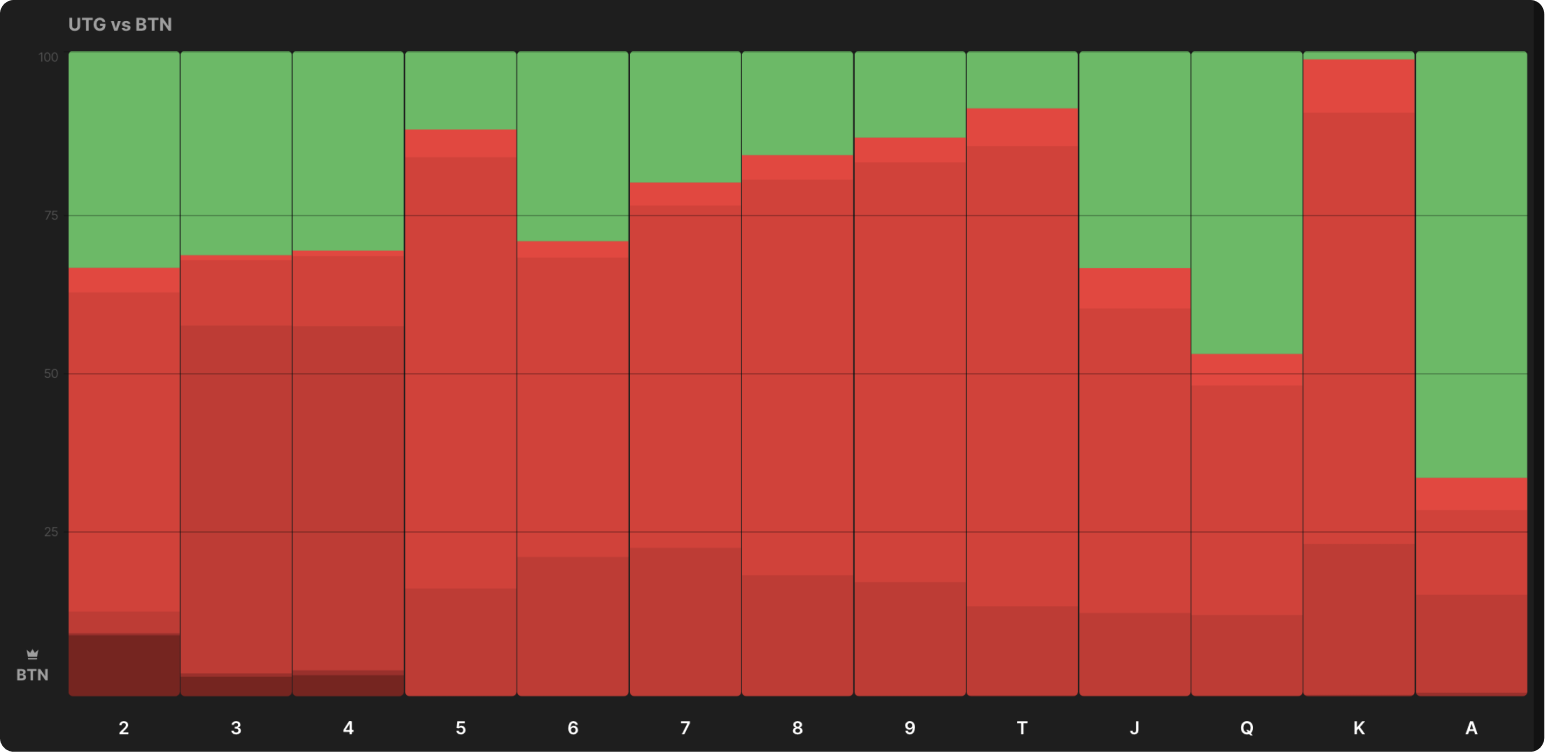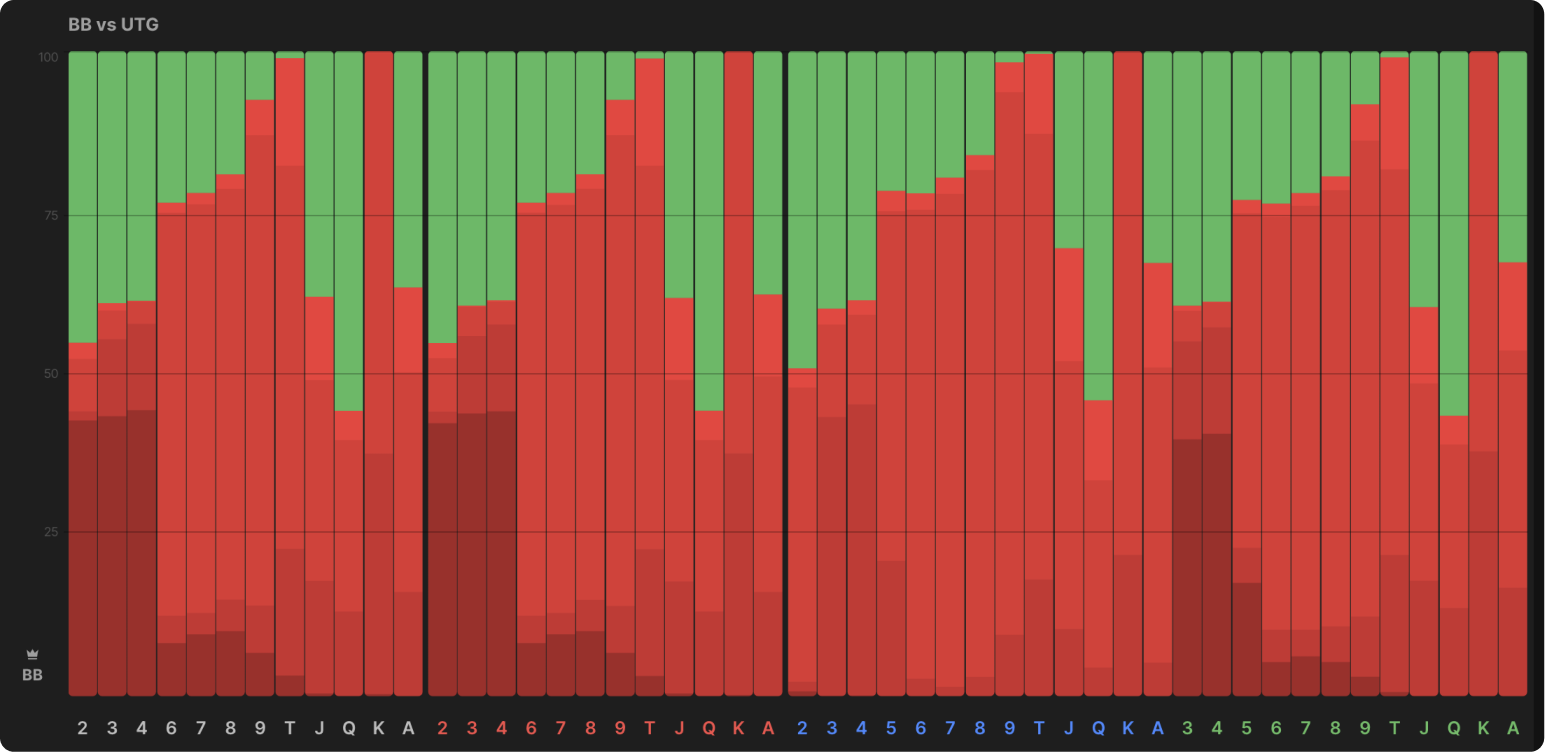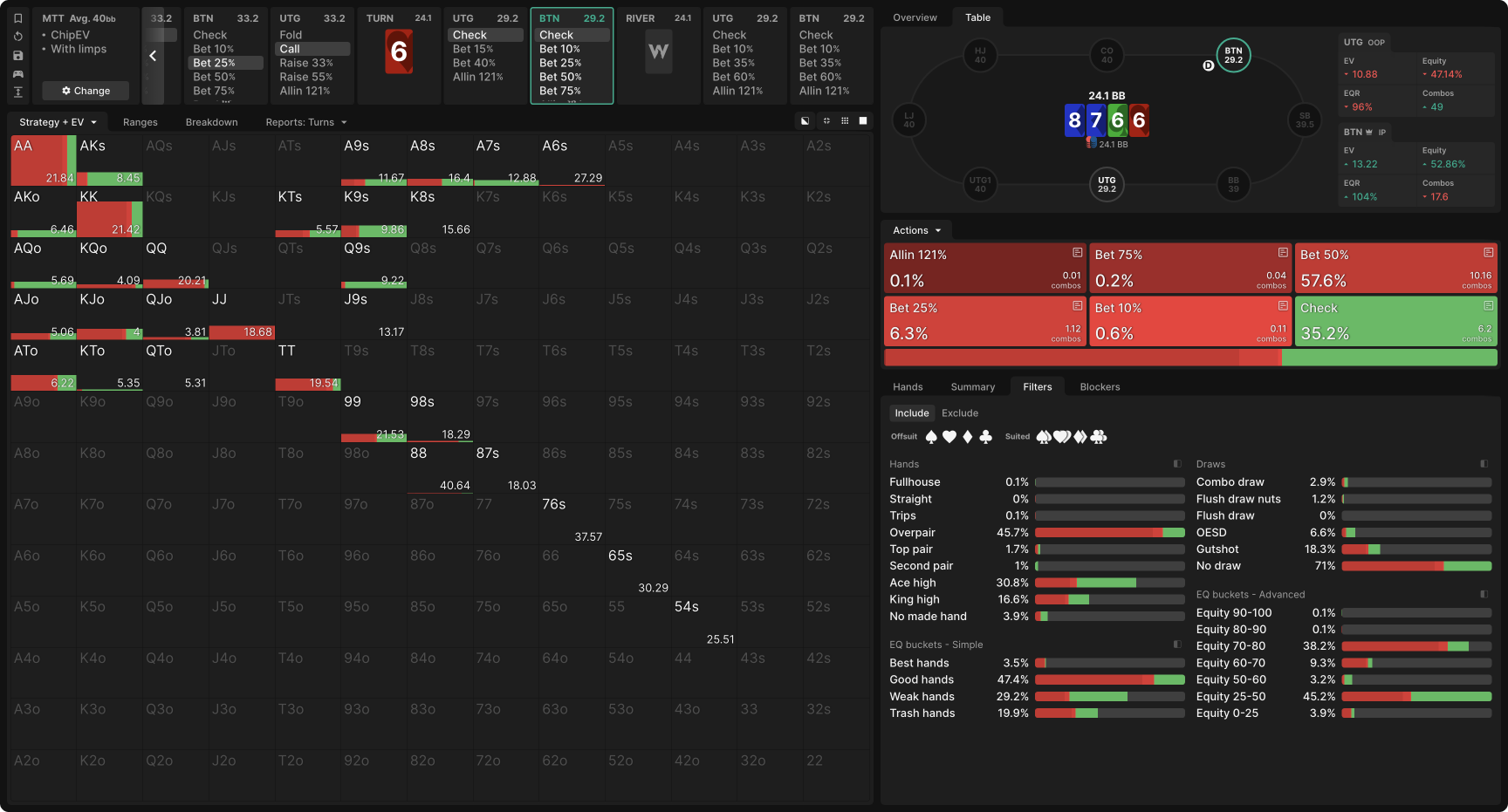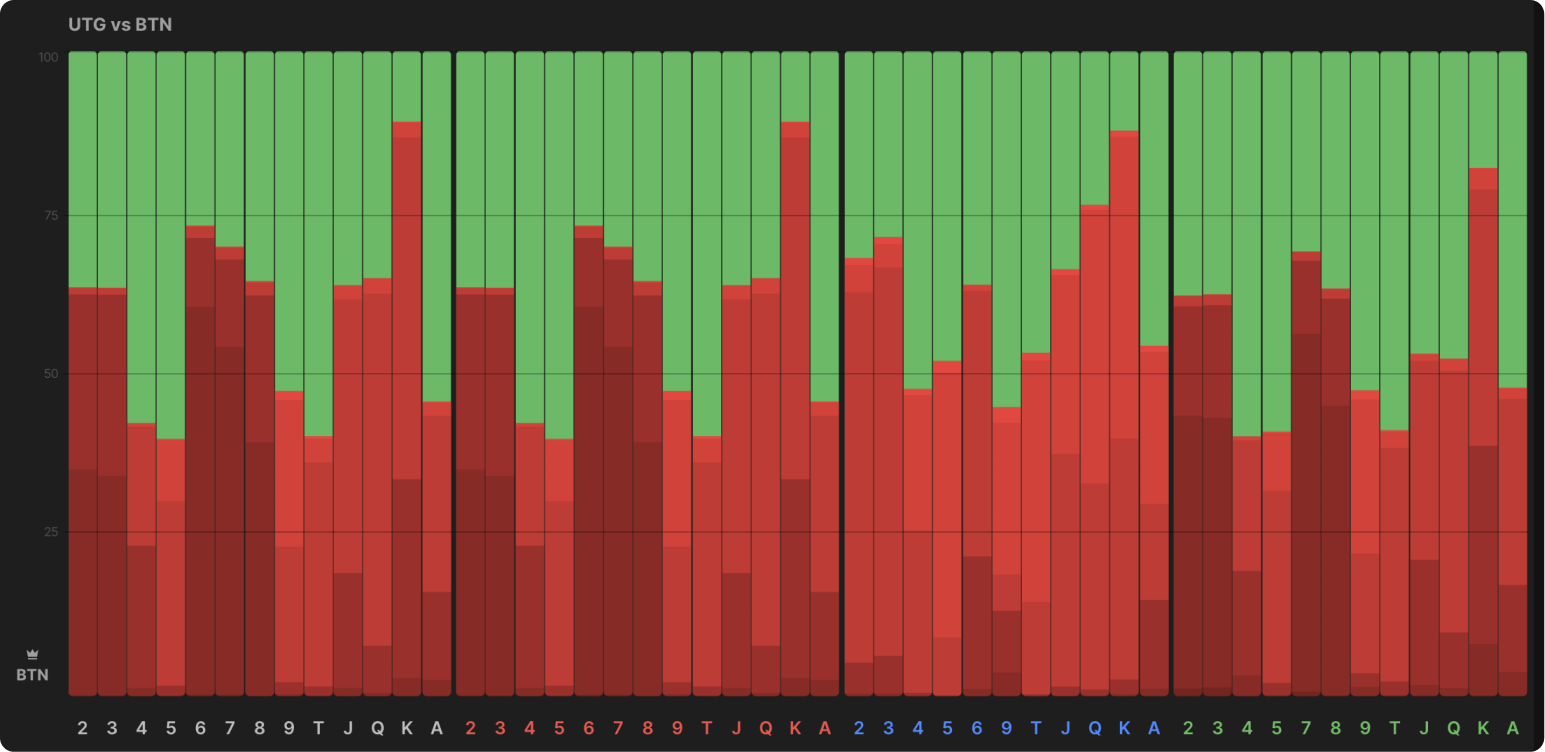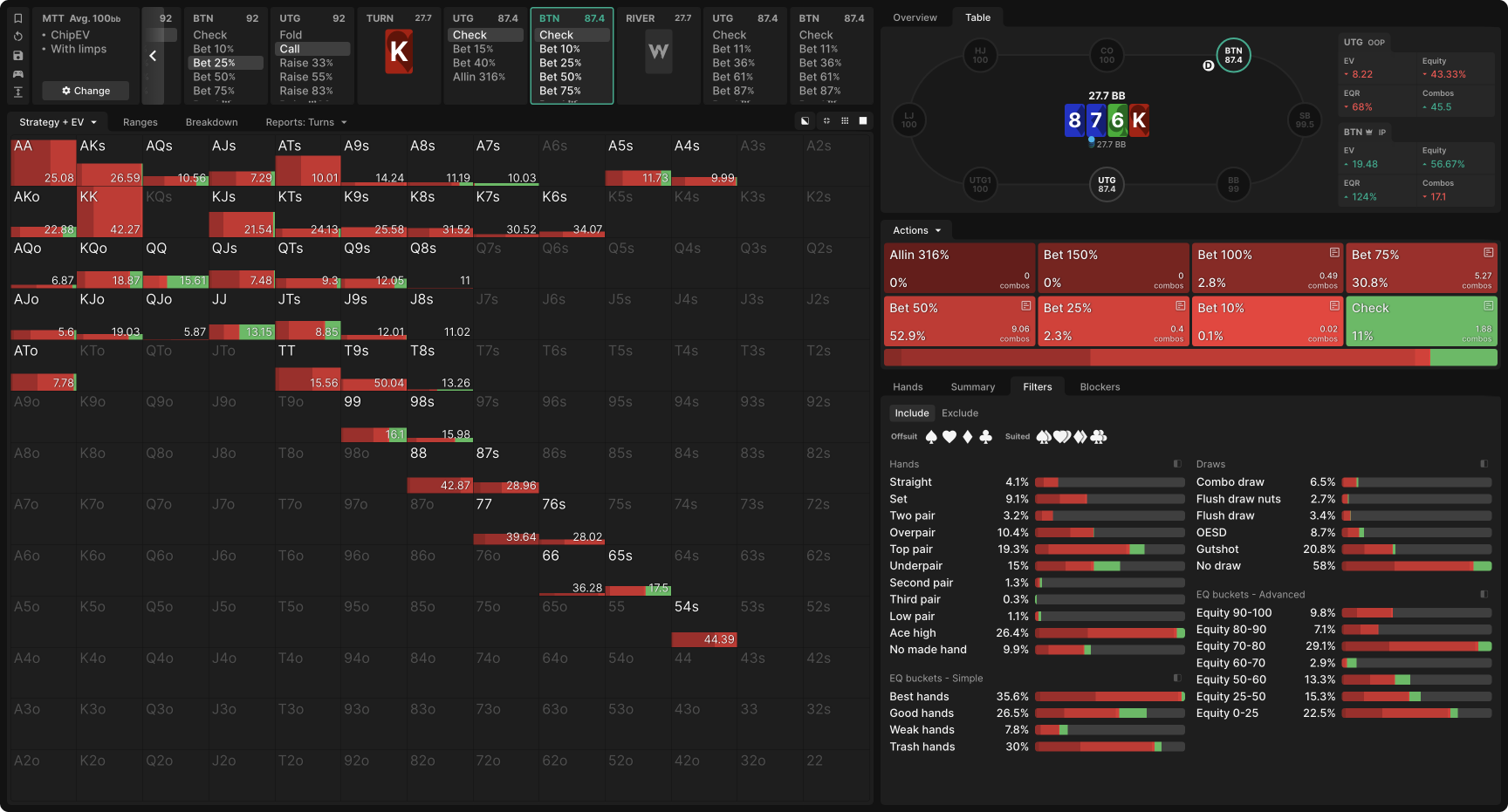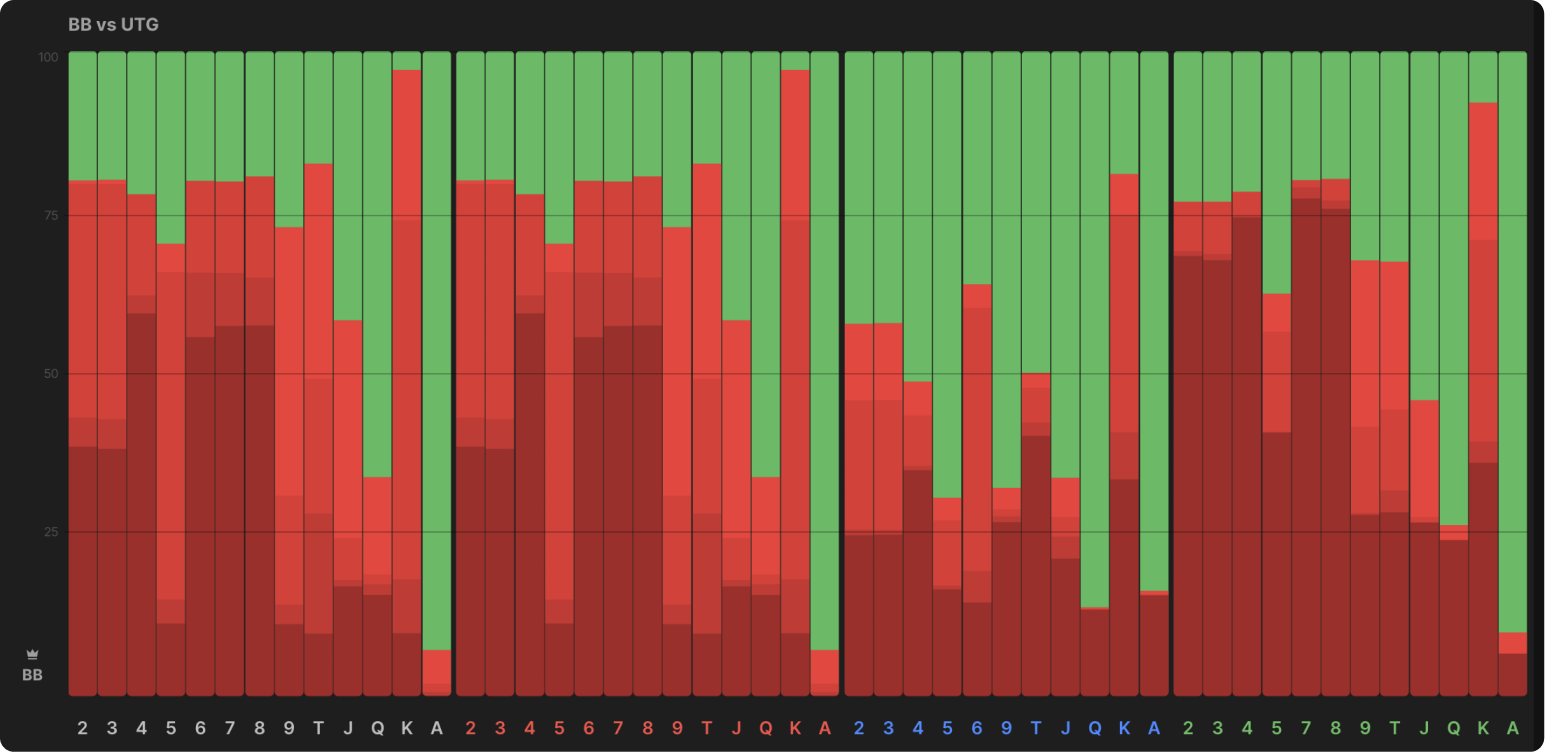Turn Barreling in 3-Bet Pots
There are two articles on the GTO Wizard blog that make good prerequisites to this piece: Principles of Turn Strategy and How to Analyze Turn Textures in Poker. If you’ve already read them and just need a quick refresher, here are the key concepts to keep in mind:
- Hand values are more clearly defined on the turn than on the flop, they have clearer incentives, and they pursue those incentives more explicitly.
- The more equity a player has, the more likely they are to bet.
- The more likely they are to hold nutted hands relative to their opponent, the more likely they are to use a large size when they bet.
In this article, we will look at how these concepts apply in 3-bet pots. 3-bet pots differ from single-raised pots in two important ways:
- Lower SPR. This makes stacking off with strong one-pair hands more appealing, which tends to give the nuts advantage to the 3-bettor even on boards that do not obviously favor them.
- Stronger Preflop Ranges. Although both players tweak their ranges to some degree to account for this, especially with deeper starting stacks, it is nevertheless true that big cards predominate both players’ ranges. The rank of your overpair or the rank of your kicker when you make top pair (especially if that pair is an Ace) is more strategically relevant than in a single-raised pot.
Blank Flops
In light of the above principles, a 552r flop is great for the 3-bettor, who can barrel aggressively on most runouts without regard for the risk of running into trips. To be clear, it’s not that there is no risk, only that it is low enough to be outweighed by other factors.
Here is BTN’s strategy on all turn cards (grouped by rank) with 100bb starting stacks in a 3-bet pot against UTG after the 50% flop continuation bet got called on 5♠5♥2♣:
The presolved solution suggests a mix of 50% and 75% pot bets on most turns, setting up a river shove that is either slightly larger or slightly smaller than the turn bet, but this is an artifact of the simulation’s construction. Using the ‘Custom solutions’ feature which enables Automatic selection of the optimal bet sizing, the AI-solver lands on 67% pot as the optimal size on a generic turn like the 9♦. This sets up a 67% pot river shove, a perfect example of geometric pot growth:
We can see as well that virtually all hands Q9 and stronger bet again for value on this turn and that overcards make the best bluffing candidates, the exceptions being AK and AQ, which have less incentive to bluff because they may win unimproved.
Positions are not a big factor here. The 3-bettor’s strategy looks nearly identical when they are UTG1 rather than BTN:
Even a BB 3-bettor barrels at similar frequencies on similar cards, with the major difference being that because their 3-bet and continuation bet were a bit larger, their turn bets are a bit smaller to maintain geometric pot growth:
When you have the nuts advantage, spreading the betting across multiple streets applies maximum pressure.
We observe a similar effect when we look at BTN vs UTG with 40bb. The SPR is just above 1, but BTN virtually never shoves, preferring to maintain geometric growth with bets of 25–50% pot:
In my experience, many human players frequently shove in this spot, based on a few misunderstandings:
- They want to “apply maximum pressure”. This is a good instinct, but when you have the nuts advantage, spreading the betting across multiple streets actually applies greater pressure. You still have the option to put all the money in eventually but can sneak in a few more cheap turn bluffs that give up on the river and win a little more when your opponent calls turn and folds river.
Spreading the betting across multiple streets actually applies greater pressure.
- They don’t want to get raised. Again, this is a good instinct, but it’s worth thinking more deeply about *why* you don’t want to get raised. Often, getting raised is an indication your opponent has a strong hand, in which case having the option to fold is preferable to having your entire stack in the pot. While it’s unfortunate to fold away your chance of improving on the river, that often amounts to just 10% equity or so–hardly the end of the world. Besides, your nuts advantage prevents your opponent from raising too aggressively.
When having the instinct of not wanting to face a raise, it’s worth thinking about why you don’t want to get raised and how likely that scenario is.
- They want to deny equity and avoid tough river decisions. This is most understandable with hands like TT or JJ which are currently quite strong but will lose a lot of value on overcard rivers. And to be fair, the equilibrium EV of shoving TT is 22.78bb on a 9♦ turn compared to 23.73bb for the 25% pot bet, so it’s not a massive mistake. But the majority of rivers are not going to be overcards, and even if they are, your hand may still be good enough to shove for value. That’s what the solver calculated, anyway. Your opponent really is not that likely to have a King or Queen after calling flop and turn bets, and with so little behind, it is not trivial for them to fold lower pairs. An Ace is a different story and you should in fact check that back; thankfully, position affords you the opportunity to do just that.
When having the reflex of wanting to deny equity and avoid tough decisions, it’s helpful to consider which hands you’re trying to deny, how valuable that is and how likely it is to face a tough decision.
Speaking of position, we do actually see a bit of turn shoving when the 3-bettor is out of position. Here’s the BB vs UTG strategy with 40bb stacks:
Pot control is trickier from out of position, giving you slightly more incentive to shove the turn, but only slightly more.
The out of position player cannot guarantee a free river card by checking, nor will they have the option to check behind on unfavorable rivers. So, they have a bit more incentive to get all-in on the turn, but only a bit more. They have a substantial shoving range on just a few specific turns, all low cards that put a flush draw on the board. On these turns, they have some incentive to shove low flush draws, medium pairs, and AK without a flush draw (stronger flush draws prefer to induce additional action).
None of these are pure shoves, either, because they are also good candidates for check-raising all-in. This has the same benefits of ending the action before the river but entices an extra stab from some of UTG’s weakest hands before blowing them off their equity:
Medium Connected Flops
Although these boards favor the 3-bettor much less than blank flops, their turn barreling frequencies are not much lower. This is because the 3-bettor has already accounted for the relative unfavorability of the flop with a lower continuation betting frequency. When they do bet the flop, it’s with a range calibrated to facilitate effective turn barreling.
Here is BTN vs UTG with 40bb starting stacks on 8♦7♦6♣:
Despite the coordinated board, BTN does very little big betting or shoving on the turn. When they do bet big, it’s almost exclusively on double flush draw boards, where rivers are most dynamic.
Mostly they’re betting a geometric size, still treating their overpairs as the nuts and setting up river shoves. The exceptions are when a 9, Ten, or a diamond turns. These cards undermine BTN’s nuts advantage, compelling them to target a weaker part of UTG’s range with a smaller size.
As is usually the case when betting geometrically, BTN’s barreling range on most turns is polar. That means they mostly aren’t betting modest pairs or draws that are in danger of getting raised. Rather, they bet strong made hands, low-equity draws (overcards, gutshots), and combo draws so strong they can call a raise:
The major change with deeper stacks is larger bet sizes on the blankest turn cards to accommodate geometric growth of the pot. This is 100bb stacks, BTN vs UTG:
On turned overcards, favoring the 3-bettor, especially an offsuit King, they actually run out of bluffs and so barrel at smaller than geometric size, which also accommodates some thinner value/protection bets:
Going back to 40bb starting stacks. We can see that, on this more dynamic board, the out of position (BB) 3-bettor mostly abandons the 3-street geometric barreling plan and plays a shove-or-check strategy when stacks allow. The exceptions are, again, the overcards which most favor them, on which they want to make thinner bets:
With deeper stacks, shoving is mostly not an appealing option, so they do more checking (sometimes check-shoving, which offers a more favorable risk:reward ratio) and block-betting:
Conclusion
After the IP player aggresses preflop, and on the flop, and receives merely calls from their opponent, they will enjoy a significant nuts advantage on most turns. To make the most of this advantage, you should seek to get stacks in using similarly sized bets on the turn and river, even when the stacks are very shallow. Only when OOP, are you incentivized to shove the turn, and even then you should do so only on the most dynamic boards.
When not shoving, your turn barreling should be polar, especially if you are in position and so have the option of guaranteeing a free river by checking. With a low SPR, your opponent does not need a great hand to shove on you, and you don’t want to get blown off your draws and medium-equity hands.
Practice
Practice your c-betting and barreling skills in 3-bet pots with these GTO Wizard drills:

Author
David Chen
David Chen is a GTO Wizard and MIT student, with a deep understanding of game theory and algorithms.




